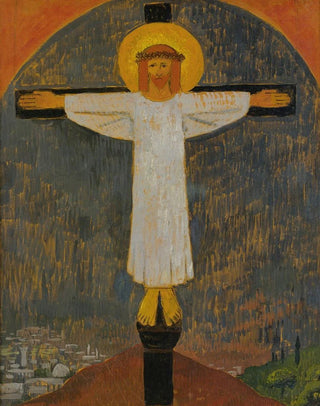Art print | The White Christ - Paul Sérusier


View from behind

Frame (optional)
In the fascinating universe of art, some works transcend time and space, captivating viewers and inspiring minds. "The White Christ" by Paul Sérusier is one of those creations that, through its spiritual depth and stylistic boldness, invites meditative contemplation. This artwork, created in 1912, stands out not only for its sacred subject but also for its innovative approach, reflecting a period of artistic transformation. Sérusier, through this representation, invites us to explore the mysteries of faith and light, immersing us in a world where color and form blend to give life to a personal vision of the divine.
Style and uniqueness of the work
"The White Christ" is characterized by a post-impressionist style, typical of Sérusier, which moves away from academic conventions to embrace a freer, more subjective expression. The color palette, dominated by bright whites and pastel shades, creates an ethereal, almost celestial atmosphere. The contours of the figures are simplified, almost stylized, emphasizing the spiritual dimension of the piece. The light, omnipresent, seems to emanate from Christ himself, enveloping the viewer in an aura of serenity. This chromatic choice and bold composition reveal a quest for transcendence, a desire to depict not only the figure of Christ but also the idea of divine light, embodied by a central figure that stands out with grace and majesty.
The artist and his influence
Paul Sérusier, a prominent member of the Nabi movement, mastered his artistic vision at the turn of the 20th century. Building on his experiences with masters like Gauguin, he developed a unique pictorial language where color becomes the central element of expression. The Nabis, of which Sérusier was a founder, advocated a symbolist approach to art, seeking to express emotions and ideas rather than faithfully reproducing reality. "The White Christ" perfectly fits this approach, combining spirituality and modernity, and bearing witness to Sérusier's lasting influence on generations of artists.

Matte finish

View from behind

Frame (optional)
In the fascinating universe of art, some works transcend time and space, captivating viewers and inspiring minds. "The White Christ" by Paul Sérusier is one of those creations that, through its spiritual depth and stylistic boldness, invites meditative contemplation. This artwork, created in 1912, stands out not only for its sacred subject but also for its innovative approach, reflecting a period of artistic transformation. Sérusier, through this representation, invites us to explore the mysteries of faith and light, immersing us in a world where color and form blend to give life to a personal vision of the divine.
Style and uniqueness of the work
"The White Christ" is characterized by a post-impressionist style, typical of Sérusier, which moves away from academic conventions to embrace a freer, more subjective expression. The color palette, dominated by bright whites and pastel shades, creates an ethereal, almost celestial atmosphere. The contours of the figures are simplified, almost stylized, emphasizing the spiritual dimension of the piece. The light, omnipresent, seems to emanate from Christ himself, enveloping the viewer in an aura of serenity. This chromatic choice and bold composition reveal a quest for transcendence, a desire to depict not only the figure of Christ but also the idea of divine light, embodied by a central figure that stands out with grace and majesty.
The artist and his influence
Paul Sérusier, a prominent member of the Nabi movement, mastered his artistic vision at the turn of the 20th century. Building on his experiences with masters like Gauguin, he developed a unique pictorial language where color becomes the central element of expression. The Nabis, of which Sérusier was a founder, advocated a symbolist approach to art, seeking to express emotions and ideas rather than faithfully reproducing reality. "The White Christ" perfectly fits this approach, combining spirituality and modernity, and bearing witness to Sérusier's lasting influence on generations of artists.






